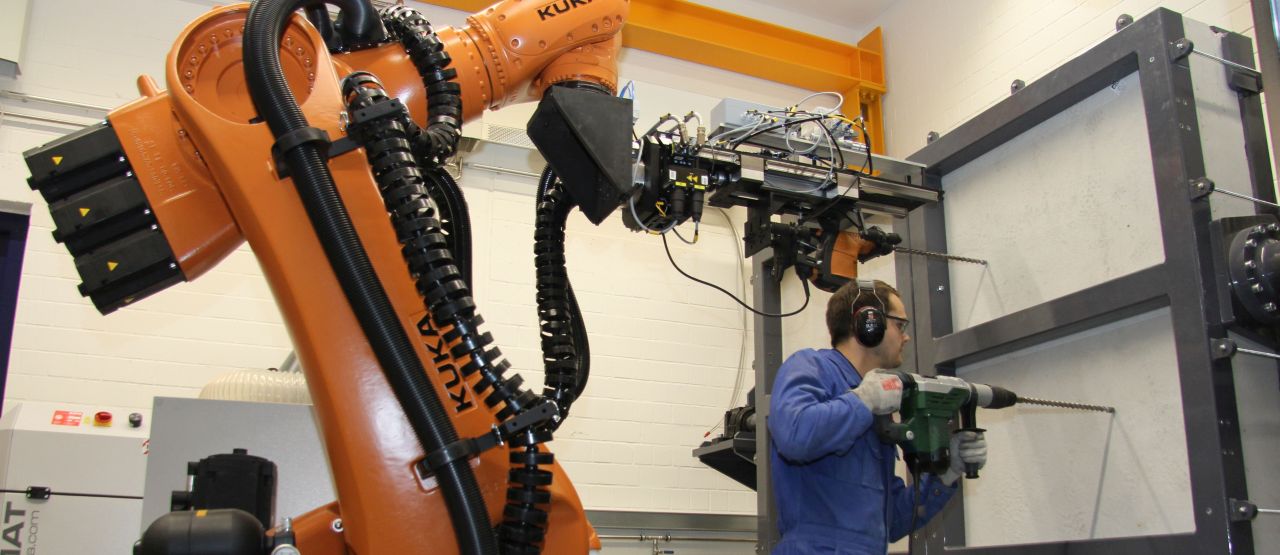Drilling, cutting, grinding, and milling: Electric tools are indispensable helpers in a craftsman’s daily routine – provided they were developed and tested under real-life conditions. These conditions now exist in the new Power Tool Test Center of Karlsruhe Institute of Technology (KIT). A computer-controlled robot arm guides the tool along defined profiles captured by sensors that track the movements of human users. The test center is funded by the German Research Foundation with EUR 800,000.
“When developing tools, it is of paramount importance to understand the overall man-machine system,” emphasizes Professor Sven Matthiesen, head of the IPEK – Institute of Product Engineering at KIT. “With the Power Tool Test Center, we are now able to study the mechanical interactions between user and tool in detail and simulate them in a reproducible way. This is the key to product innovation.”
The purpose of the new Power Tool Test Center is to enable automated testing of electric tools (also referred to as power tools) under a reproducible user influence and thus eliminate the uncertainties involved with hand-held tests by humans. The user behavior is analyzed and integrated into automated tests in the form of reproducible and configurable parameters. During the development phase of power tools, comprehensive hand-held testing is necessary. Since the tools must be tested by many different persons, the results are highly varied. Thanks to the use of robots that guide the tools in the same way as humans would do, but with reproducible movements, the man-machine interaction can now be investigated in a scientifically accurate way and leveraged for the development of the tools.
The Power Tool Test Center has three test benches. At the user interaction test bench (AIP), the mechano-dynamic properties of a user working with power tools are investigated. A computer transmits measured or simulated movements to a sensing handle (electromechanical shaker) at the test bench. Then, the forces and torques between the user’s hand and the handle are captured. Even high accelerations, such as jolting vibrations common when using hammer drills or impact wrenches can be simulated. Since the sensing handle can be positioned freely, it is also possible to test working overhead or on the ground.
At the automated power tool test bench (APP), the measured user influence can be mapped in a reproducible way. For this purpose, the arm of an industrial robot guides the electric tool by following exactly the captured force profiles of a user. The power tool interaction test bench (PIP) finally allows to examine tools when working on the most diverse working surfaces in any possible spatial orientation and to test them under real-life conditions. Different surface types, such as concrete, wood, or metal can be positioned in any orientation by means of an automated, flexible surface positioning system. This makes it possible to conduct hand-held tests as well as automated tool tests in any spatial orientation and to identify and measure the interactions. The first series of tests conducted at the KIT Power Tool Test Center involve hammer drills and angle grinders. Further cooperation projects with manufacturers are being planned. The budget of the Power Tool Test Center is approx. EUR 2.3 million, of which EUR 800,000 are financed by the German Research Foundation (DFG).
IPEK-XiL: the IPEK-X in-the-loop approach
The complex interaction of mechanical, electric, and computing components in modern devices requires systematic and highly integrative development processes and engineering environments. As early as possible in the product design process, it must be possible to test individual components in a realistic environment, although prototypes of the overall system are not available yet.
For this purpose, KIT developed, among other things, the IPEK-X in-the-loop approach (IPEK-XiL), which is also used in the Power Tool Test Center. With this approach, simulation-based coupling is used to validate components such as a power tool or an electric tool. In this context, individual user behavior is reproduced by highly dynamic actuators using specific models and simulations. This approach, which can be based on simulation and actuators, allows to vary system parameters very flexibly and efficiently analyze the effects or to exchange data and parameters that were acquired at test benches at different geographic locations and at different points in time.
Being “The University in the Helmholtz Association”, KIT creates and imparts knowledge for the society and the environment. It is the objective to make significant contributions to the global challenges in the fields of energy, mobility, and information. For this, about 10,000 employees cooperate in a broad range of disciplines in natural sciences, engineering sciences, economics, and the humanities and social sciences. KIT prepares its 22,800 students for responsible tasks in society, industry, and science by offering research-based study programs. Innovation efforts at KIT build a bridge between important scientific findings and their application for the benefit of society, economic prosperity, and the preservation of our natural basis of life. KIT is one of the German universities of excellence.

